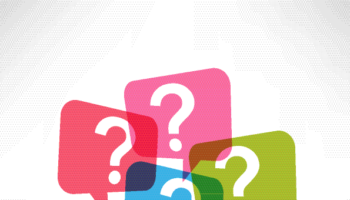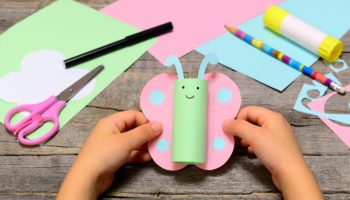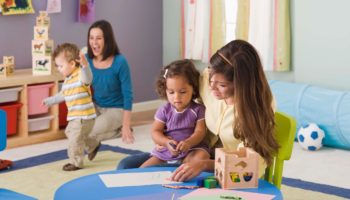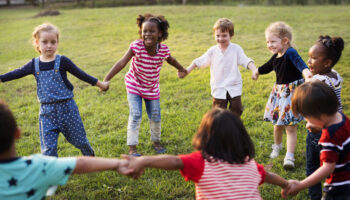Erin DelRegno Evans
“Childhood is not a race to see how quickly a child can read, write, and count. It is a small window of time to learn and develop at the pace that is right for each individual child. Earlier is not better.” − Magda Gerber
There’s a reason people say, “It’s just like riding a bike.” Because you truly LEARNED how to ride a bike. Even if you haven’t ridden one in years, no matter how old you are, you could get back on and ride (even though it may take some of us a minute or two to get started). I want you to think about how you learned to ride a bike in the first place though. Did you listen to someone talk about bicycles, did you read a book about how to ride one, watch a YouTube video…. then you were good to go and could get on one and ride, right? No, of course not! You wanted to learn so you practiced. You needed to figure out steering, speed, balance, etc. You probably even started with training wheels. Learning to ride a bicycle takes time and patience. The process isn’t always quick, but it is worth it because you learned it for life. Maybe riding a bike doesn’t work for you so, think about learning to drive a car…it’s the same concept.
Let’s even look at this in a different way, planting a flower. How do you get it to grow? Do you tell it to grow, and it grows? Does it grow when you want it to, or do you have to give it the water, sunshine, and time it needs to grow and bloom? What if one of the flowers doesn’t sprout when you expect it to; do you give up on that flower because it didn’t bloom at the same time as the one next to it? It is a process, and you must be patient and give it the care and attention it needs. And don’t forget that overwatering is not the answer; this could hurt a flower’s chance to bloom.
Just like the process it takes to ride a bike or for a flower to grow, learning is a process. And every child learns and progresses in their own time and in their own way. As you work with the children in your care, are you being supportive and nurturing their development and learning along the way, or are you interrupting this process and stopping them from progressing as they are meant to? Let’s look at some different activities commonly used in classrooms and see if they focus on the process of learning.
Flash cards:
Children younger and younger are being drilled with facts. Flash cards focus on memorization rather than communication and language skills. A child may be able to say that is a picture of a cup, but do they know that represents the real thing they use at lunch time? A child may be able to recite what numbers they see on flash cards or on the circle time calendar, but do they understand that the written number is a symbol for a physical amount. Please do not mistake rote memorizing with learning.
Worksheets:
I’m sure you remember doing worksheets in school, I know I do. But is this developmentally appropriate for young children? Worksheets are set up to be completed in one way and look for only one right answer. They don’t provide the opportunity for language development, creativity, movement, problem solving, etc. You can have children count pictures or circle the object that is bigger on a worksheet, but those concepts will develop naturally during play where children are more engaged and can see and touch actual objects. Additionally, worksheets tend to be something completed independently by a child, so there is little interaction with teachers and peers. Much more learning takes place when children are in a stimulating environment and can interact with their peers and an active, encouraging teacher.
Are flash cards and worksheets even very interesting or engaging for children? Remember that children learn through play. Children need more than a picture; they need interactions with their teachers and real-life experiences where they can explore hands-on materials and play. Think about it, would you rather look at a picture of a dump truck or play with the one in the block area? Or maybe there is a real one outside to look at and talk about. Children learn and build true understanding when they can use and look at something real. Your interactions with them during play can also be much more purposeful and meaningful than they would be when using flash cards or worksheets. You can expand on children’s knowledge and interests by having back-and-forth discussions, describing what you see, asking questions to get them thinking, providing new information, etc.
Product vs. Process Art:
Do you plan a lot of teacher-directed art projects for your children? Do you pre-cut pieces for them, have them follow a model, or use coloring sheets? Are there specific materials you chose for them to use, and do they have to use them in a particular way? Even if the children can put the eyes anywhere they want, their final products will still look very similar. These types of projects are focused on the end product and not on the process the children take to create it. There are stages of drawing and writing, and if all children do is put pieces of paper onto glue, they are not getting the opportunity to practice the skills needed to progress forward.
Remember that art activities should not just be about getting the planned activity done, it’s about what children learn during the process. It is important that the art activities you do are open-ended. Children should have the opportunity to freely express themselves through their work and explore and experiment with a variety of materials. Think about how you want to spend your time; do you want to prep all these extra materials and just focus on making sure the project is done the right way, or would you rather take the time to have children share their knowledge and ideas prior to creating? Encourage them to talk about their creations while they are making them and ask them questions so you can learn more.
“It must not be forgotten that the basic law of children’s creativity is that its value lies not in the results, not in the product of creation, but in the process itself. It is not important what children create, but that they do create, that they exercise and implement their creative imagination.” − Lev Vygotsky
“What” learning objectives you are focusing on only matter through “how” you use time and materials to get the most out of every moment. It’s not about children getting the right answer or doing everything the right way, but on the process and individualizing for each child based on where they are developmentally. Provide them with open-ended activities and be there to support them as they progress. They will be genuinely learning, and you will all have fun in the process.
Resources:
Toddlers and Reading: Describe but Don’t Drill (NAEYC)
Why don’t worksheets belong in early learning & Kindergarten programs?
Process Vs. Product: The Importance of Individual Expression Through Art
Creative Art with Young Children (video)
The Value of Process Art (vodcast)




